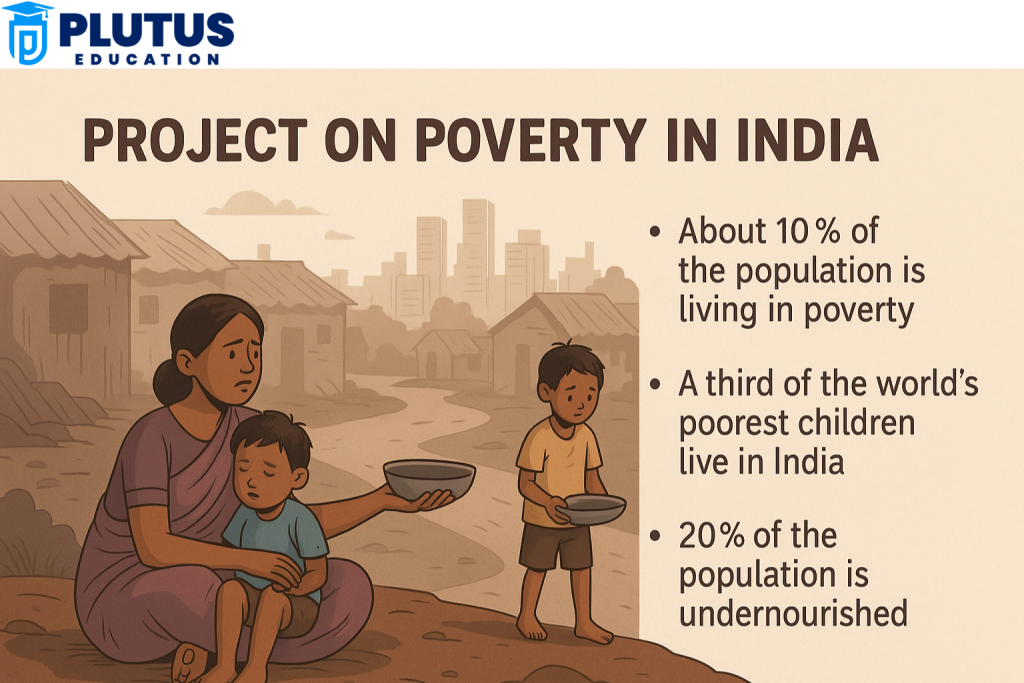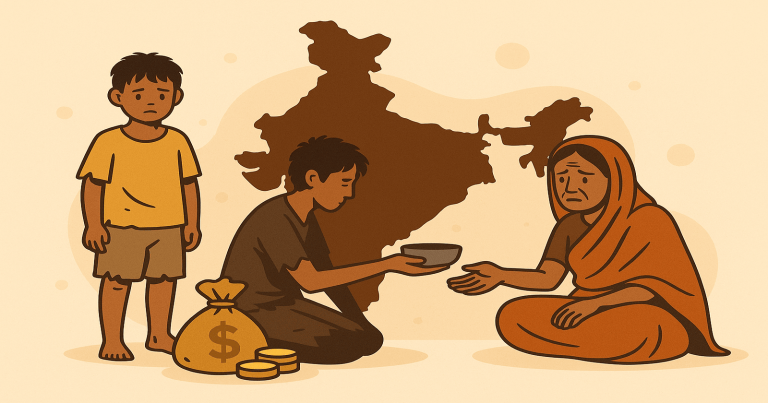The Poverty in India project aims to study the causes, problems, and effects of poverty and also to look at the effectiveness of the available government schemes and solutions. Poverty is such an issue in India, which as one of the most populous countries in the world, is plagued by socio-economic challenges. By conducting research and harvesting data, this project enables us to ascertain the fundamental reasons and also assess viable approaches to fight the scourge of poverty. Knowledge of poverty and its implications will also help policymakers, NGOs, and other actors to come up with effective measures of tackling the problem of poverty.
What is a Project on Poverty?
A poverty alleviation project project consists of various components related to a sociological study of poverty and its ramifications on people’s social life. It entails various research methodologies such as collecting data, analyzing questionnaires, and other relevant elements aimed at understanding the economic, social, and environmental factors leading to poverty. A well-conducted project discusses important relevant elements like geographic diversity, the role of gender, the factors of education and jobs, and strategies implemented in fighting poverty.
Key Elements of a Project on Poverty
- Data collection: Compiling statistics on poverty levels and their determinants to present a profile of the people in the area and their income status.
- Socio-Economic Case: Focusing on the case of a person or persons, in or outside the community who are situated in poverty.
- Evaluation research: Assessment of the scope and implementation of poverty eradication strategies.
- Program Evaluation: Assessment of existing national anti-poverty programs.
Projects on Poverty in India
1. Integrated Rural Development Programme (IRDP): It was first introduced in 1978-79 and made effective from October 2, 1980, in order to assist rural poor by providing subsidy and bank credit for self-employment throughout the subsequent plan periods.
2. Jawahar Rozgar Yojana/Jawahar Gram Samridhi Yojana: Employment and underemployment in the rural areas of the country are truly facilitated through economic building, community, and social assets, this was the basic philosophy behind the introduction of JRY.
3. Food for Work Programme: It is mainly a wage employment program to enhance food security. Food grains are provided to states on subsidy; therefore, the flow of food grains from the FCI (Food Corporation of India) godowns has been considerably sluggish.
4. Rural Housing Indira Awaas Yojana: This INDIRA AWASS YOJANA (LAY) scheme aims at providing housing free of cost to families in rural areas who are classified as Below Poverty Line (BPL) while aimed at maintaining the objectives would be the households of SC/STs.

Challenges Faced by a Project on Poverty in India
It is quite difficult for anyone to do a project focused on poverty in India especially because of the varying socio-economic conditions of the place, the large population, and the scope of differences across the regions. There are normally challenges that researchers face in obtaining correct data and assessing the effects of policies set by the government.
1. Data Collection and Accuracy: Geographical dispersion and remoteness can lead to poor and older data. There are gaps in estimating household income due to the presence of a large informal sector.
2. Registries Containing Information on Provinces and Growth Overview: The section poses a challenge to study because there is more impoverishment in rural areas than in cities. To illustrate, in states such as Bihar, Uttar Pradesh, and Odisha northern states fare worse relative to advances registered by southern states.
3. Effects of Social Disparities: Certain sects find it easier to sink into poverty in old age due to harmful socially constructed ways of living such as caste system, gender discrimination, and illiteracy. The less-endowed economic classes of women, children, and the disadvantaged are even more aggressive in their pursuit of economic empowerment.
4. Bulkiness and Inaccessibility of Facilities: Basic health services, education, and transport facilities are barely available in these remote areas making it painstakingly impractical to carry out surveys in these regions.
5. Effects of the Environment: External Globalization; for example, global warming, economic oppression or recession as manifested by pandemics like COVID-19 Canadian Thanks Release the Violence 88 percent heightens the level of poverty further complicating the research.
6. Monitoring and Evaluation Constraints: In many instances, it is almost impossible to trace the impact of programs such as MGNREGA because of barriers posed by bureaucratic and corrupt practices.
Purpose of a Project on Poverty
Every project on poverty has a core aim of looking at the various dimensions of poverty and coming up with ways to reduce it. Although that project, if one may call it so, tackles the factors and consequences of poverty, it also evaluates how the government, non-governmental organizations, and society as a whole have been able to combat this menace.
- Apprehending the vicious cycle of poverty: Examining potential causes such as joblessness, education, and social inequities.
- Appraising the Strengths and Weaknesses of Anti-Poverty Programs: Government welfare schemes aimed at poverty alleviation or employment such as PDS, MGNREGA, and Skill India Mission.
- The Importance of Enlightening the Public: The stakeholders need to be informed about the consequences of extreme poverty, health, education, and economic development.
- Proposing Suggestions: Policy suggestions, community-based interventions, and viable options for the elimination of poverty.
- Observing Shortcomings: Observing inadequacies in the execution of the present poverty-defeating efforts.
Consequences of Poverty in India
Poverty in India not only implies a lack of monetary resources but has a more profound impact on the health, education, and quality of life in general. Poverty leads to a cycle such that when a person has no or very little income one is unable to afford quality education and healthcare which in turn leads to the lack of jobs. It is unnecessary to say that confronting these challenges is important for promoting inclusive and sustainable growth.
Social & Economic Consequences of Poverty
1. Effects on health and nutrition: Malnutrition and undernourishment are common in children. Because of the lack of medical health services, the prevalence of diseases is higher, and the mortality rate is also high.
2. Children’s Education and Employment Problems: Children from economically weak families tend to leave school early to assist their families. Unemployment and low employment rates are prevalent thus resulting in high levels of poverty, especially in cities and the countryside slums.
3. Growth of Social Inequality: Poverty increases inequality in caste, gender, and religion, as well as social segregation among various classes.
4. Consequences on Economic Development: The poverty of a significant part of the population remains a serious obstacle to the country’s progress in economic development. An unproductive way of living and mastering useful skills does not benefit the poor.
5. Increase in Social Malady: A view that illiteracy promotes child abuse. Unemployment, violence, juvenile delinquency, and other social evils are on the rise. Urbanization is accompanied by rural-urban migration causing congestion and pressure on available facilities.
Project on Poverty FAQs
What are the Major Factors Causing Poverty in Indian Society?
The major factors responsible for the existence of poverty in India are unemployment, illiteracy, social discrimination, lack of health care, and other basic amenities.
Justify why it is relevant to work on poverty as a project in India.
A project on poverty in India looks into the situation and effects of poverty, explains the policies aimed at reducing poverty, their advantages and limitations and finally proposes feasible strategies that will fight against poverty.
How does poverty impact education in the Indian context?
Poverty is the reason why children are unable to continue their education because they have to work to help support their family, which in turn reduces their chances of getting a job in the future and continues the cycle of poverty.
How can MGNREGA help the poor people in the country?
The MGNREGA scheme ensures that every rural household gets guaranteed employment for 100 days in a year thereby providing them with a financial safety net and alleviating rural poverty.
Where can I get additional materials or even statistics on the causes of poverty in India?
In-depth analysis or additional information on the subject matter of poverty in India can be found on appropriate government websites, research articles and other project work on poverty in India available on the internet.


